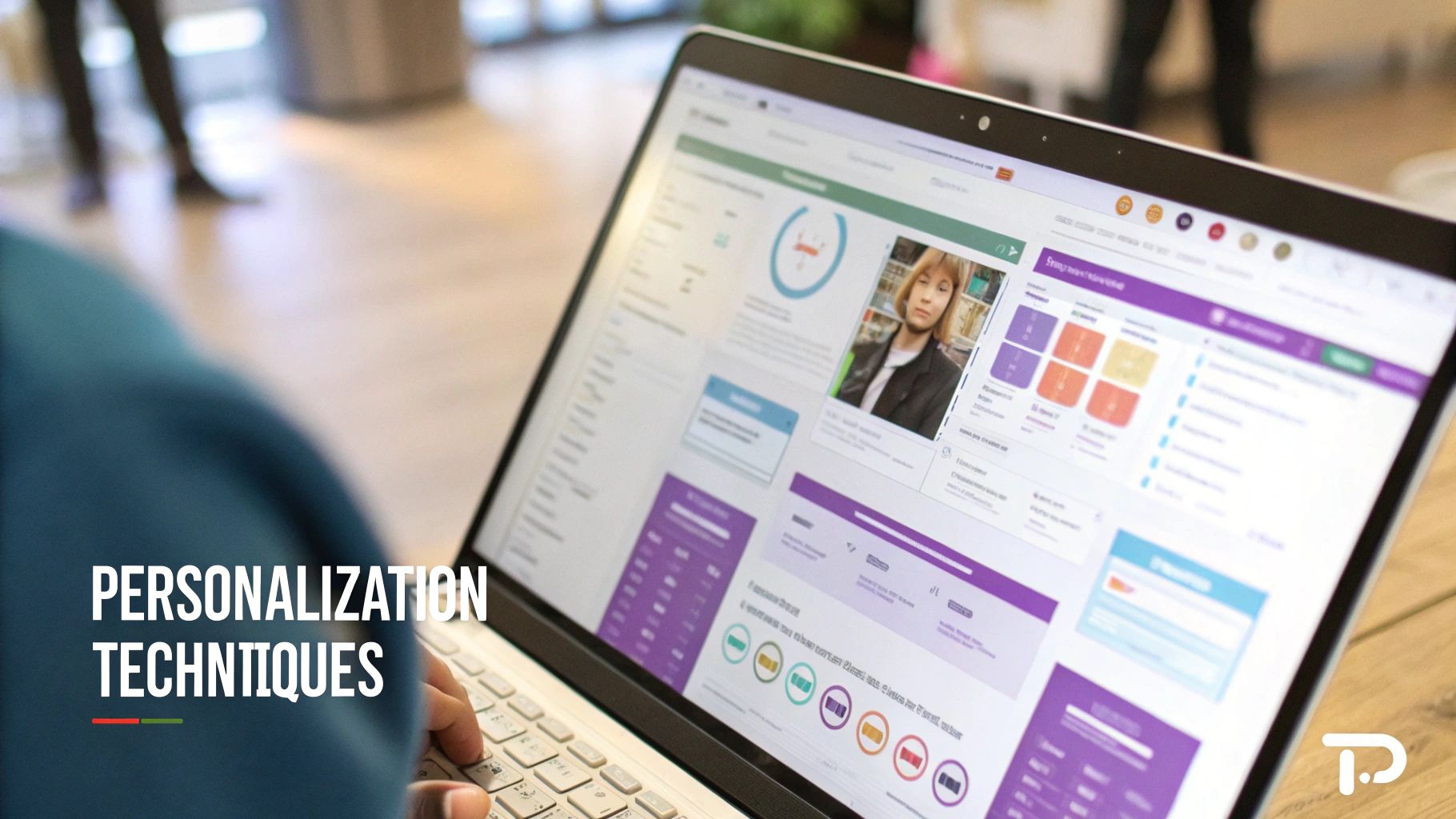Understanding Customer Journey Orchestration Fundamentals
Customer journey orchestration is more than just a popular concept. It represents a significant change in how businesses interact with their customers. It goes beyond simply tracking customer interactions and focuses on creating dynamic, responsive experiences. This means companies are actively anticipating customer needs and adjusting interactions in real-time to offer truly personalized experiences. These experiences are crafted to guide customers smoothly towards their goals, building loyalty and driving business growth.
Beyond Traditional Customer Management
Traditional customer management approaches often fall short because they view each interaction as a separate event. This can create disjointed and frustrating experiences for customers. For instance, imagine a customer contacting support repeatedly for the same problem, having to provide their information every time. This not only harms customer satisfaction but also reveals operational inefficiencies. Customer journey orchestration, on the other hand, connects these touchpoints, creating a unified and cohesive experience.
Core Components of Orchestration
What makes customer journey orchestration successful? The key is integrating data from multiple sources and using real-time decision-making. This means businesses need to connect their CRM systems (Salesforce), marketing automation platforms (HubSpot), and other customer data sources to get a complete view of each individual. This combined data then allows businesses to personalize interactions at each touchpoint, delivering the right message at the right time through the right channel. Real-time decision-making also enables dynamic adjustments to the customer journey based on individual behavior and preferences. You might be interested in: How to master consistent customer experience across channels.
The Rise of Data-Driven Engagement
The growing importance of customer journey orchestration is evident in the increasing use of related technologies. The adoption of customer journey analytics and orchestration (CJA/O) technologies has been rising significantly. As of 2025, businesses are recognizing the value of real-time, data-driven engagement to provide personalized experiences across multiple channels. Learn more about the growth of CJA/O here: CSGI Insights. This trend highlights the move towards a more customer-focused strategy, where businesses prioritize understanding and addressing individual customer needs throughout their entire journey. This proactive approach is essential for building strong customer relationships and maximizing customer lifetime value.
Building Real-Time Personalization That Actually Works
Creating personalized experiences at scale requires more than just wishful thinking. It demands a strategic approach to customer journey orchestration that delivers measurable results. This means using customer data effectively to deliver the right message at the right time, without overburdening your team or exceeding your budget. This is essential for businesses looking to boost customer engagement and build lasting loyalty.
Behavioral Segmentation Beyond Demographics
Truly effective personalization begins with understanding your customers. This goes beyond simple demographics and digs deeper into their behaviors and preferences. Behavioral segmentation allows you to group customers based on their actions, such as purchase history, website browsing activity, and email interactions.
For instance, a customer who regularly browses your new arrivals page might appreciate early access to sales or new product announcements. This focused approach ensures your messages are relevant to each individual, improving the chances of a conversion.
Dynamic Content That Adapts
After segmenting your audience, the next step is developing dynamic content that adapts to each customer's individual journey. This involves customizing your messaging and offers according to their current stage in the buying process.
A first-time visitor might receive a welcome discount, while a loyal customer could be offered exclusive access to a new product line. This personalized approach enhances the overall customer experience and creates a sense of value and helps boost customer lifetime value.
Maintaining Consistency Across Channels
Providing a seamless experience across all channels is crucial for effective customer journey orchestration. Whether a customer interacts with your brand through email, social media, your website, or a mobile app, the experience should be consistent and personalized.
This requires integrating your various communication channels and ensuring consistent messaging across all touchpoints. For more on streamlining multi-channel communication, check out our guide on automating customer support.
Visualizing the Customer Journey

The infographic above illustrates effective touchpoint mapping in a modern workspace. It highlights the flowcharts and journey nodes that are essential for successful customer journey orchestration. This detailed mapping helps businesses gain a deeper understanding of customer interactions across various platforms, enabling them to optimize each touchpoint for maximum impact. As a result, businesses can anticipate customer needs and personalize interactions, driving engagement and building loyalty.
Avoiding Common Pitfalls
While personalization offers many advantages, it's important to avoid common pitfalls. One significant challenge is over-personalization, which can feel intrusive to customers. Another pitfall is relying solely on automated systems without human oversight. This can lead to impersonal and irrelevant interactions.
The key is finding a balance between automation and human touch. Use data to inform personalized experiences while maintaining a genuine connection with your customers. This ensures that your efforts resonate positively and build trust, rather than alienating your audience. By focusing on genuine customer needs and preferences, you can create personalized experiences that feel natural and valuable, ultimately driving engagement and loyalty.
To further illustrate the different approaches to personalization, let's take a look at the following comparison:
Personalization Tactics Comparison
Comparison of different personalization approaches with their effectiveness and implementation complexity
| Personalization Method | Customer Impact | Implementation Effort | ROI Timeline |
|---|---|---|---|
| Basic Segmentation (Demographics) | Low | Low | Short-term |
| Behavioral Segmentation | Medium | Medium | Mid-term |
| Dynamic Content Personalization | High | High | Long-term |
As this table shows, while basic demographic segmentation is easy to implement, its impact is limited. Behavioral segmentation requires more effort but yields better results. Dynamic content personalization offers the highest potential impact but demands the most significant investment in terms of implementation and resources. The ROI timeline also reflects this, with more complex personalization tactics requiring more time to demonstrate a return.
Leveraging AI and Automation For Journey Enhancement
Artificial intelligence is changing how businesses understand and respond to customer behavior. The real power, however, lies not in replacing human insights with AI, but in enhancing them. This collaborative approach allows businesses to leverage the strengths of both human expertise and AI capabilities, creating more effective customer journey orchestration.
Predicting Customer Needs With AI
AI algorithms analyze vast amounts of customer data to predict future needs and behaviors. This predictive capability allows businesses to anticipate customer needs and proactively offer solutions. For instance, if a customer regularly purchases a specific product, AI can predict when they might need a refill and automatically send a reminder or offer a discounted subscription.
This proactive service enhances the customer experience and encourages repeat purchases. Furthermore, AI can personalize recommendations and offers, making each interaction more relevant and valuable. This targeted approach boosts conversion rates and strengthens customer relationships.
Automating Personalized Communications
AI empowers businesses to automate personalized communications without sacrificing authenticity. Using Natural Language Processing (NLP), NLP AI generates customized messages that resonate with individual customers. This allows businesses to send targeted emails, personalized offers, and even real-time chat responses that feel genuine.
This personalized approach can dramatically improve customer engagement and drive conversions. However, it's essential to strike a balance between automation and human interaction to build meaningful connections.
Identifying Optimization Opportunities
AI can identify optimization opportunities that human analysis might miss. By examining complex customer journey data, AI pinpoints bottlenecks, friction points, and areas for improvement. This allows businesses to streamline processes, improve conversion rates, and enhance the customer experience.
For example, AI might reveal that customers are abandoning their shopping carts at a particular stage of checkout. This insight allows the business to identify the issue and optimize the checkout flow to reduce cart abandonment. Generative AI is becoming increasingly important in customer journey analytics. It promises to improve the automation of real-time personalized communications and offer deeper insights into customer behavior. Learn more about this growing field: 2025 Gartner Market Guide.
Turning Data Into Actionable Insights
Forward-thinking organizations use AI to translate massive amounts of customer data into actionable insights. This allows businesses to make data-driven decisions that improve customer satisfaction and drive measurable business outcomes.
By analyzing customer behavior patterns, preferences, and pain points, businesses can create targeted strategies for customer journey orchestration that deliver tangible results. These insights inform everything from product development to marketing campaigns, aligning every facet of the business with customer needs. This data-driven approach is essential for competitive advantage and building customer loyalty. Through AI-powered insights, businesses improve operational efficiency and create more personalized and effective customer experiences.
Mastering Multi-Channel Orchestration Success

Managing consistent customer experiences across multiple channels presents a significant challenge for businesses today. It requires more than just simple coordination; it demands strategic customer journey orchestration. This means shifting the focus from individual interactions to a holistic view of the entire customer lifecycle, irrespective of how customers choose to engage with your brand.
Creating Seamless Multi-Channel Experiences
Customers interact with businesses through a variety of channels, from email and social media to mobile apps and in-person visits. Customer journey orchestration ensures a seamless and personalized experience across all these touchpoints. It's about understanding customer behavior and preferences to tailor interactions for maximum impact.
For instance, imagine a customer abandoning an online shopping cart. A well-orchestrated journey might trigger a follow-up email with a discount code. If the purchase remains incomplete, a personalized message through a website chatbot could offer further assistance.
Tracking Customer Behavior Across Channels
Effective orchestration relies on tracking customer behavior across different channels. This involves collecting data from various sources and integrating it into a unified customer profile. However, responsible data handling is crucial. Protecting customer privacy and being transparent about data usage builds trust and fosters stronger relationships.
This responsible approach also allows for more accurate personalization and a smoother customer experience. By anticipating customer needs and delivering relevant messages at each touchpoint, businesses can enhance engagement and build loyalty.
Making Every Touchpoint Count
In a well-orchestrated journey, every touchpoint contributes meaningfully to the overall customer experience. This means optimizing each interaction for maximum impact and aligning it with the customer's current needs and goals. The benefits of this approach are quantifiable.
Research shows that effective multi-channel orchestration significantly improves key metrics. Studies across 3,000 customer touchpoints reveal that businesses implementing true orchestration achieve 89% higher customer satisfaction scores. They also see a 156% improvement in customer lifetime value compared to those managing channels independently. For a deeper dive into these statistics, check out this study: Multi-Channel Orchestration Study.
Breaking Down Channel Silos
Many businesses grapple with channel silos, where different departments manage separate channels without sufficient coordination. This can lead to fragmented and inconsistent customer experiences. Customer journey orchestration requires breaking down these silos and adopting a unified approach to customer engagement.
This involves integrating different teams and technologies, ensuring a seamless flow of information and a consistent brand experience. This creates a more cohesive and satisfying experience, leading to increased customer loyalty and higher lifetime value. By focusing on integrated experiences that feel natural and valuable, businesses can cultivate stronger, more profitable customer relationships.
Measuring ROI and Journey Performance That Matters

Effective customer journey orchestration relies on robust measurement. This means looking beyond surface-level metrics and diving into actual business impact and return on investment (ROI). This section explores identifying key performance indicators (KPIs) that truly reflect customer journey success and demonstrate real value.
Establishing Meaningful KPIs
Enhance your measurement strategy by exploring our key performance indicators for customer service.
Forget vanity metrics like website visits or social media followers. Your KPIs should align directly with your business objectives.
Think about metrics like conversion rates, customer lifetime value, and customer churn rate. These offer valuable insights into your orchestration efforts and paint a clear picture of your progress.
Also, consider measuring customer satisfaction with metrics like Net Promoter Score (NPS) and Customer Satisfaction (CSAT). These provide crucial feedback for optimization by reflecting the customer's experience.
Tracking Customer Progression
Advanced analytics are key to tracking customer progression. This involves monitoring customer movement through touchpoints and identifying friction or drop-off points.
For example, analyzing cart abandonment can reveal valuable insights. This data can then improve the checkout process and reduce lost sales.
Attributing Revenue to Orchestration Efforts
Connecting specific orchestration activities to revenue is crucial. This means linking touchpoints in the customer journey to actual sales or conversions.
By establishing this link, you can directly attribute revenue gains to your efforts and provide concrete evidence of effectiveness. For more information on related cost savings, check out this article: Learn more in our article about reducing call center costs.
This data-driven approach showcases the value of orchestration and justifies continued investment.
Continuous Optimization Based on Performance Data
Customer journey orchestration is an ongoing process. Regularly analyze performance data to identify areas for optimization and refine your strategies.
This iterative approach, based on real-world customer behavior, keeps your efforts aligned with customer needs and drives positive results. This involves monitoring KPIs, identifying trends, and making data-backed adjustments to improve customer experience and maximize ROI.
Frameworks For Ongoing Improvement
A structured framework for data analysis is essential for effective orchestration. This framework defines how data is collected, analyzed, and used for decisions.
A clear process ensures consistent monitoring and improvement, leading to more efficient and impactful efforts. This includes defining roles and responsibilities, setting reporting timelines, and outlining the process for implementing data-driven changes.
Measuring The True Impact of Orchestration
Successful organizations focus on the tangible impact of their orchestration investments. They go beyond vanity metrics and prioritize KPIs directly related to business goals.
By demonstrating a clear link between orchestration and improved outcomes, these organizations secure continued support and funding for their customer experience initiatives. This data-driven approach validates customer-centric strategies and justifies ongoing investment.
KPIs and Benchmarks
To help you organize and track key metrics related to customer journey orchestration, consider using a table like the one below.
Journey Orchestration KPIs and Benchmarks
Essential metrics for measuring customer journey orchestration success with industry benchmarks
| KPI Category | Key Metrics | Industry Benchmark | Measurement Method |
|---|---|---|---|
| Customer Acquisition | Customer Acquisition Cost (CAC), Conversion Rate | Varies by industry | Track marketing campaign performance and sales data |
| Customer Retention | Customer Churn Rate, Customer Lifetime Value (CLTV) | Industry averages available | Analyze customer purchase history and engagement |
| Customer Satisfaction | Net Promoter Score (NPS), Customer Satisfaction Score (CSAT) | Compare to competitors | Conduct customer surveys and feedback analysis |
| Efficiency | Cost per Conversion, Support Resolution Time | Internal benchmarks and industry best practices | Track operational costs and support metrics |
This table offers a starting point adaptable to your specific business objectives. Tracking these KPIs allows you to effectively measure the impact of customer journey orchestration and demonstrate its value to stakeholders.
Market Growth And Future Opportunities
The customer journey orchestration landscape presents exciting prospects for businesses ready to adapt. Understanding market trends, staying current with new technologies, and choosing the right orchestration solutions are key to success. Forward-thinking companies are already using these advancements to improve customer experiences and boost growth.
Current Market Trends in Customer Journey Orchestration
A major trend is the rising demand for personalized customer experiences. Customers now anticipate businesses to recognize their individual needs and preferences, tailoring interactions accordingly. This has led to increased adoption of AI-powered personalization tools that analyze customer data to deliver targeted messaging and offers.
Another significant trend is the growing importance of omnichannel communication strategy. Customers engage with businesses across various channels, expecting a consistent and seamless experience on each one. This makes it crucial to integrate communication channels and provide a unified brand experience.
Emerging Technologies Shaping the Future of CX
Emerging technologies are set to reshape customer journey orchestration. Artificial Intelligence (AI) and Machine Learning (ML) are becoming increasingly important in automating personalized communication, predicting customer behavior, and optimizing customer journeys. Artificial Intelligence and Machine Learning allow businesses to analyze large amounts of customer data and gain valuable insights.
Real-time data analytics empowers businesses to dynamically adjust customer interactions based on current context and behavior. This creates more relevant and timely experiences, improving customer satisfaction and loyalty. Cloud-based solutions offer scalability and flexibility for businesses implementing and managing their orchestration strategies.
Growth Trajectory of Orchestration Solutions
The customer journey orchestration market is expanding rapidly, reflecting the growing complexity and expectations around customer journeys. The market is expected to achieve a substantial compound annual growth rate (CAGR) by 2028, driven by the demand for personalized customer experiences. Learn more about this market growth here. This growth creates compelling opportunities for businesses leveraging orchestration solutions to improve customer engagement strategies.
Strategic Approaches for Staying Ahead of the Competition
To thrive in this changing market, businesses need strategic approaches focused on the customer and data-driven decisions. This includes investing in the right technology, developing in-house expertise, and fostering a culture of continuous improvement.
Businesses should prioritize these key areas:
- Investing in a robust customer data platform (CDP): A customer data platform allows businesses to collect, unify, and analyze customer data from various sources.
- Implementing AI-powered orchestration tools: These tools automate personalization, predict customer behavior, and optimize journeys in real time.
- Developing a strong understanding of customer journeys: This involves mapping key touchpoints and identifying areas for improvement.
- Building cross-functional teams focused on customer experience: This ensures a unified approach to customer engagement across all departments.
- Continuously measuring and optimizing orchestration efforts: This data-driven approach allows businesses to adapt to evolving customer needs and market dynamics.
By embracing these strategies, businesses can position themselves for success in the increasingly orchestration-driven market and meet rising customer expectations. This proactive approach improves customer experiences and drives sustainable business growth. Successfully navigating this dynamic landscape requires technological innovation, strategic planning, and a commitment to exceptional customer experiences.
Key Takeaways
Customer journey orchestration empowers businesses to move beyond reactive customer service and create proactive, personalized experiences. This requires a strategic approach, the right technology, and a commitment to continuous improvement. This section offers practical guidance and actionable strategies for building an orchestration program that delivers measurable results.
Building Cross-Functional Teams
Orchestration requires collaboration. Breaking down silos between departments like marketing, sales, and customer service is crucial. Cross-functional teams ensure a unified approach to customer engagement, preventing disjointed experiences. This fosters a customer-centric culture throughout the organization.
For example, imagine a customer engaging with a brand through social media, then browsing the website, and finally contacting customer support. A cross-functional team ensures consistent messaging and a smooth transition between these touchpoints.
Maintaining Momentum During Digital Transformation
Implementing customer journey orchestration often involves significant digital transformation. Maintaining momentum requires clear goals, consistent communication, and demonstrable quick wins. Celebrating early successes, no matter how small, keeps teams motivated and reinforces the value of orchestration.
Regular progress updates and open communication channels keep everyone informed and aligned. This transparency minimizes confusion and keeps the project on track.
Avoiding Common Obstacles
Several common pitfalls can derail customer experience initiatives. Over-personalization, for instance, can feel intrusive and damage customer trust. Another obstacle is relying solely on automation without human oversight, leading to impersonal interactions. A successful orchestration strategy finds the right balance between automation and human touch, using data to personalize experiences while retaining genuine human connection.
Inadequate data integration can also hinder personalization efforts. Ensure your systems communicate effectively to gain a complete view of each customer. This integrated data empowers you to tailor interactions and create truly personalized experiences.
Actionable Strategies for Success
To build a successful customer journey orchestration program, consider the following:
- Start with a digital transformation roadmap: Define your goals, target audience, and key touchpoints.
- Choose the right technology: Select tools that integrate with your existing systems and provide the necessary functionalities for data analysis, automation, and personalization. Consider platforms like HubSpot for managing customer relationships and marketing automation.
- Focus on continuous improvement: Regularly analyze performance data, gather customer feedback, and adjust your strategies accordingly.
Measuring Progress and Demonstrating ROI
Measuring the impact of your orchestration efforts is essential. Focus on key performance indicators (KPIs) that align with your business objectives, such as conversion rates, customer lifetime value, and customer satisfaction scores.
By tracking these KPIs and analyzing their trends, you gain valuable insights into what's working and what needs improvement, allowing you to optimize your orchestration strategies.
Timeline Expectations for Measurable Results
While some benefits of customer journey orchestration are immediate, others take time. Implementing a new platform, integrating data sources, and training teams requires upfront investment. However, well-executed orchestration can deliver significant returns, including reduced support costs, increased sales, and higher customer retention.
Implementing a chatbot for handling routine inquiries can quickly reduce support costs. However, building a fully personalized customer journey across all channels requires a longer-term strategy.
Looking for a platform to streamline your customer journey orchestration? FlowGent AI empowers you to deploy intelligent AI agents across multiple channels, delivering seamless, human-quality support 24/7. Transform your customer experience today.



